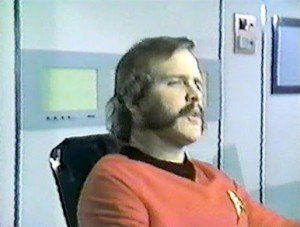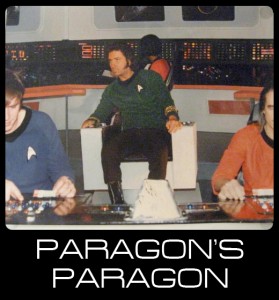 Estimates from the Vulcan Academy of Sciences place the number of Star Trek fan films currently on YouTube and Vimeo at approximately 16,489,247. Personally, I think they’re a little low. But let’s face it: there’s a LOT of Star Trek fan films out there!
Estimates from the Vulcan Academy of Sciences place the number of Star Trek fan films currently on YouTube and Vimeo at approximately 16,489,247. Personally, I think they’re a little low. But let’s face it: there’s a LOT of Star Trek fan films out there!
And unless you have waaaaaaay too much free time on your hands, you probably can’t watch every Star Trek fan film. And that’s where this blog comes in. I’m planning to spotlight a bunch of my favorites, telling you exactly why I think they’re MUST SEE STAR TREK.
I’m also planning to look at a number of the lesser-know fan films and series, and tell you a bit about some gems (and some rocks) that you might otherwise have never even known existed.
When I can, I’m going to try to provide interviews with the fan filmmakers themselves. All of them are truly interesting (dare I say fascinating???) people who managed to accomplish what so few fans can claim: they’ve made their own filmed Star Trek to share with others.
But before we begin looking at some of the best and brightest the fans have to offer, I thought it would be a hoot to look back on the very first-ever Star Trek fan film. No, it’s not New Voyages or Hidden Frontier. They’re barely a decade and a half old! We need to set the Guardian of Forever back to the year 1974!
Ah, 1974…
Through the gateway mists, we see that the original Star Trek had been showing only in reruns for the past half-decade, although Filmation had just finished airing its first season of an animated Star Trek cartoon show. George Lucas was still tweaking a first-draft screenplay called “The Star Wars,” and the first Star Trek feature film was still half a decade away.
Many fans were hungry—famished even!—for more Star Trek, desperate for any morsel of trivia not revealed in those 79 hour-long episodes. Novels were starting to get published, blueprints and technical manuals were being worked on, and fan fiction was proliferating everywhere. Some fans were even creating their own Star Trek home movies, although nothing was overly impressive yet.
I should note that the earliest Star Trek fan films dated back to when the original series was still playing on first-run broadcast TV on NBC. But those were typically just kids in their living rooms being filmed on Super 8 by their parents, playing Star Trek without much of a script or preparation.
But a fan in Michigan took things one step farther. He spent nearly $2,000 of his own money (that’s about $15,000 today!) to turn a 65-page script into a 100-minute long film entitled Paragon’s Paragon. A little less than half that money went to create sets that looked like this…
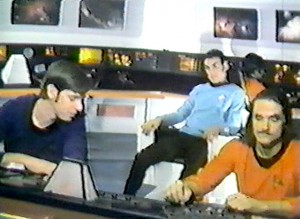 That fan’s name was (and still is!) John Cosentino, a carpet-layer by trade (working for his father at the time) who was also an artist, engineer, and amateur filmmaker. Prior to tackling what would become his magnum opus, John had made a series of shorter (12 to 30 minute) comedy films. But Star Trek was his love, and he spent months researching materials and prices, designing and building sets and props, collecting costume patterns (and getting his mother, a seamstress, to sew them!), producing make-up prosthetics for Klingons, Organians, and a Vulcan (each alien requiring one-and-a-half to two hours to prepare in make-up), and even developing and printing his own enlarged slides for the screen displays on the bridge panels.
That fan’s name was (and still is!) John Cosentino, a carpet-layer by trade (working for his father at the time) who was also an artist, engineer, and amateur filmmaker. Prior to tackling what would become his magnum opus, John had made a series of shorter (12 to 30 minute) comedy films. But Star Trek was his love, and he spent months researching materials and prices, designing and building sets and props, collecting costume patterns (and getting his mother, a seamstress, to sew them!), producing make-up prosthetics for Klingons, Organians, and a Vulcan (each alien requiring one-and-a-half to two hours to prepare in make-up), and even developing and printing his own enlarged slides for the screen displays on the bridge panels.
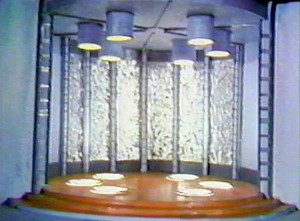 Along with the bridge set (built in John’s basement, of course!), he and his friends constructed a transporter room, starship mess hall, officer’s quarters, briefing room, turbolift, a portion of the exterior of a
Along with the bridge set (built in John’s basement, of course!), he and his friends constructed a transporter room, starship mess hall, officer’s quarters, briefing room, turbolift, a portion of the exterior of a  shuttlecraft, and the interior of a Klingon ship. Twelve Starfleet crew uniforms were sewn, along with two Klingon outfits and three Organian robes. Along with make-up materials, camera equipment and batteries, and lighting…it’s a wonder John Cosentino was able to do it all for as little money as he did!
shuttlecraft, and the interior of a Klingon ship. Twelve Starfleet crew uniforms were sewn, along with two Klingon outfits and three Organian robes. Along with make-up materials, camera equipment and batteries, and lighting…it’s a wonder John Cosentino was able to do it all for as little money as he did!
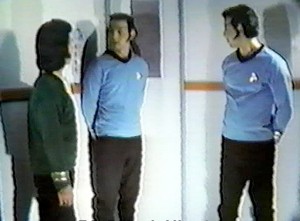 As with many productions today, the most impressive set, and the most difficult to build, was the bridge. And remember that these were the days before TVs had the ability to freeze frame so that you could carefully measure and analyze the sets on the Trek episodes, although there were publicity photos available. And so John did his best to design and build something that looked as close to the original Enterprise bridge as he could, and he got pretty darn close!
As with many productions today, the most impressive set, and the most difficult to build, was the bridge. And remember that these were the days before TVs had the ability to freeze frame so that you could carefully measure and analyze the sets on the Trek episodes, although there were publicity photos available. And so John did his best to design and build something that looked as close to the original Enterprise bridge as he could, and he got pretty darn close!
 Wood and wood paneling was combined with cardboard/ chipboard, Plexiglas, acetate, and a host of other building materials painted with oil-based paint (since water-based paint would warp the cardboard). Buttons were colored marbles sunk halfway into a hole. Below those marbles were 60 and 100-watt light bulbs wrapped in aluminum foil cups to reflect and intensify the light. And because these lights got hot around materials that were flammable, they placed asbestos paper between the material and the bulb. Yes, asbestos! Welcome to 1974.
Wood and wood paneling was combined with cardboard/ chipboard, Plexiglas, acetate, and a host of other building materials painted with oil-based paint (since water-based paint would warp the cardboard). Buttons were colored marbles sunk halfway into a hole. Below those marbles were 60 and 100-watt light bulbs wrapped in aluminum foil cups to reflect and intensify the light. And because these lights got hot around materials that were flammable, they placed asbestos paper between the material and the bulb. Yes, asbestos! Welcome to 1974.
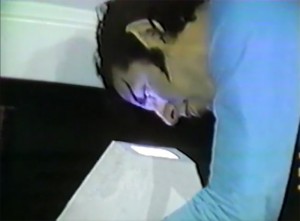 But the fire danger didn’t end there! In order to have a blue glow emanate from the viewer on the science station, a powerful 500-watt bulb was placed inside. This meant that scenes with the science officer looking into his viewer had to be filmed in only one minute max before the bulb would get too hot and burn out! Also, a layer of Plexiglas was placed inside the viewer to protect the actor’s eyes just in case the 500-watt light bulb exploded! Oh, the things we do for Trek.
But the fire danger didn’t end there! In order to have a blue glow emanate from the viewer on the science station, a powerful 500-watt bulb was placed inside. This meant that scenes with the science officer looking into his viewer had to be filmed in only one minute max before the bulb would get too hot and burn out! Also, a layer of Plexiglas was placed inside the viewer to protect the actor’s eyes just in case the 500-watt light bulb exploded! Oh, the things we do for Trek.
The lights behind the bridge panels were all Christmas tree bulbs wired to blinkers, and the acetate covering the holes was painted in different translucent colors. All told, hundreds of feet of wire, plugs, and sockets were scattered like a spider web behind those few bridge panels, and they used about 3500 watts of electricity. The studio lights sucked another 4000 watts while filming on the bridge, and occasionally, someone upstairs making an unannounced pot of coffee or using the toaster in the kitchen upstairs would blow the fuse box! Other disturbances during filming included the sound of the dishwasher, a flushing toilet, or even just the footsteps of someone walking around on the first floor being easily picked up by the microphones.
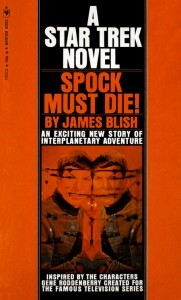 The story itself was loosely based on the first-ever original Star Trek novel “Spock Must Die!” by James Blish. To avoid ripping off Star Trek completely, though, the starship name was changed to the USS Paragon (hence, the title of the film: Paragon’s Paragon), the captain was now Richard Kirk, the first officer Mr. Sellek, Doctor Costa, Helmsman Tokato, etc. Without going into too much detail, the Kligons find a way to project an energy field around the planet Organia, cutting off the Organians’ powers and allowing the Klingons to start an interstellar war. In trying to beam Mr. Spock, er, Mr. Sellek through the field, he is split in two: one good and one evil. But unlike “The Enemy Within,” they both appear identical in temperament and logic, each explaining why he alone is the true Vulcan first officer. Ultimately, Kirk can only allow one to live, but how does he choose?
The story itself was loosely based on the first-ever original Star Trek novel “Spock Must Die!” by James Blish. To avoid ripping off Star Trek completely, though, the starship name was changed to the USS Paragon (hence, the title of the film: Paragon’s Paragon), the captain was now Richard Kirk, the first officer Mr. Sellek, Doctor Costa, Helmsman Tokato, etc. Without going into too much detail, the Kligons find a way to project an energy field around the planet Organia, cutting off the Organians’ powers and allowing the Klingons to start an interstellar war. In trying to beam Mr. Spock, er, Mr. Sellek through the field, he is split in two: one good and one evil. But unlike “The Enemy Within,” they both appear identical in temperament and logic, each explaining why he alone is the true Vulcan first officer. Ultimately, Kirk can only allow one to live, but how does he choose?
The movie was shot in Super 8 sound and color and shown at the occasional convention over the ensuing years. So where is Paragon’s Paragon today? Unfortunately, time and decay have taken their toll on the original Super 8 film, and even the beta copies made years later have given into the effects of the earth’s magnetic field. What remains isn’t much to look at, and the sound and dialog can barely be heard now. But there are a few highlights that have been edited together and can be found on YouTube here.
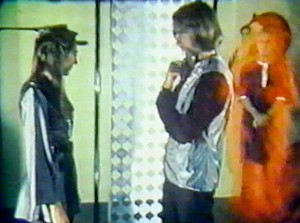 By today’s standards of green screen, digital effects, professional actors, and the resources of crowd funding, Paragon’s Paragon looks pretty weak in comparison. And of course, the acting was probably not all that great, as these were just a group of Trek fans in Michigan and not classically trained thespians. But looked at through the lens of 1974, John Cosentino was a visionary who was able to accomplish an amazing feat. Today’s fan film show-runners walk in footprints that John made over four decades ago.
By today’s standards of green screen, digital effects, professional actors, and the resources of crowd funding, Paragon’s Paragon looks pretty weak in comparison. And of course, the acting was probably not all that great, as these were just a group of Trek fans in Michigan and not classically trained thespians. But looked at through the lens of 1974, John Cosentino was a visionary who was able to accomplish an amazing feat. Today’s fan film show-runners walk in footprints that John made over four decades ago.
So as you watch the parade of fan films that I will discuss and recommend for you in the coming weeks and months, please take a moment to remember the dream and determination of John Cosentino and Paragon’s Paragon. He was truly the first of us to go where no fan had gone before…
As mentioned, the original fan film is not available online. But you can watch an 8-minute montage of scenes from Paragon’s Paragon on YouTube here.

